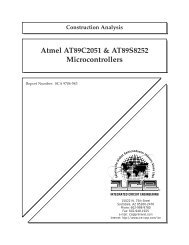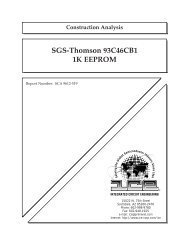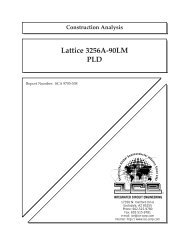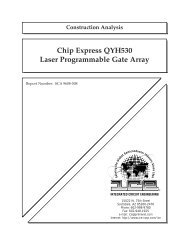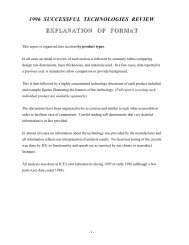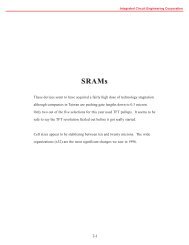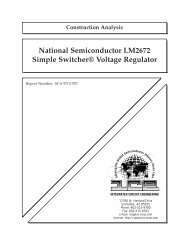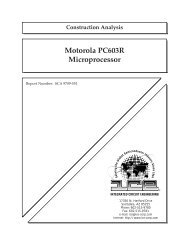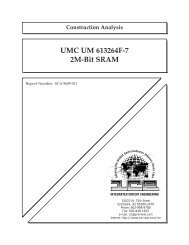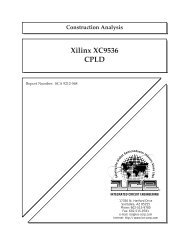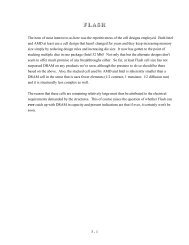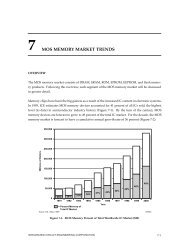Chapter 2. COST PER WAFER - Smithsonian - The Chip Collection
Chapter 2. COST PER WAFER - Smithsonian - The Chip Collection
Chapter 2. COST PER WAFER - Smithsonian - The Chip Collection
Create successful ePaper yourself
Turn your PDF publications into a flip-book with our unique Google optimized e-Paper software.
Cost Per Wafer<br />
Figure 2-24 shows further differences<br />
between DRAM and ASIC manufacturing.<br />
<strong>The</strong> high-volume DRAM manufacturing<br />
lines suffer little from reconfiguration and<br />
capacity additions relative to ASIC fabs. <strong>The</strong><br />
cost benefits due to automated scheduling,<br />
and wafer and mask tracking for ASICs outweigh<br />
the same benefits to the DRAM manufacturer.<br />
However, too much automation<br />
can inhibit flexibility. In addition, equipment<br />
reliability, mean time to repair (MTTR),<br />
and the importance of being able to quickly<br />
make real-time process changes, are much<br />
more important to the ASIC manufacturer.<br />
Development equipment must be extremely<br />
comparable to manufacturing equipment as<br />
yield ramp-up for ASICs must be minimized.<br />
As far as manufacturing cycle time and work<br />
in process (WIP) are concerned, the fab with a<br />
greater number of different products being<br />
processed at once (greater variability) will<br />
reach higher levels of WIP and longer cycle<br />
times, faster (Figure 2-25). Achieving low<br />
cycle time in the presence of variability<br />
requires either flexible equipment or idle time.<br />
2-18<br />
Modularity<br />
Benefits Due to Computer<br />
Integrated Manufacturing<br />
Important Equipment<br />
Characteristics<br />
Cost of Reconfiguration<br />
Cost of Capacity Additions<br />
Automated Downloading<br />
Wafer/Mask Tracking<br />
Scheduling<br />
Reliability<br />
MTTR<br />
Defect Free<br />
Real Time Process Change<br />
Dev. Eqpt. = Mfg. Eqpt.<br />
Other Key Cost Trends<br />
In addition to product yield, cycle time, labor<br />
costs, and equipment productivity, important<br />
components in cost per wafer include<br />
the cost of equipment maintenance, test<br />
wafers, and consumables. Although discussing<br />
every cost components in detail is<br />
beyond the scope of this book, some highlights<br />
provides insight into their importance:<br />
¥ Contracted maintenance costs vary<br />
between nothing ($0) for the first two<br />
years, to up to $400,000 per tool per year,<br />
depending on the equipment supplier and<br />
terms of the contract.<br />
¥ Equipment installation, including tool<br />
hook-up and the running of test wafers to<br />
full qualification, typically adds 35 percent<br />
to the price of the tool.<br />
¥ <strong>The</strong> cost of cleaning gases for single-wafer<br />
tools is significantly higher than for batch<br />
tools. In-situ cleaning procedures also contribute<br />
significantly to tool downtime.<br />
Issues Measure<br />
ASIC DRAM<br />
High<br />
High<br />
High<br />
High<br />
High<br />
High<br />
High<br />
Medium<br />
High<br />
High<br />
Low<br />
Medium<br />
Low<br />
Low<br />
Low<br />
Medium<br />
Medium<br />
High<br />
Medium<br />
Medium<br />
Source: Motorola 19775<br />
Figure 2-24. Relative Fab Characteristics<br />
INTEGRATED CIRCUIT ENGINEERING CORPORATION



